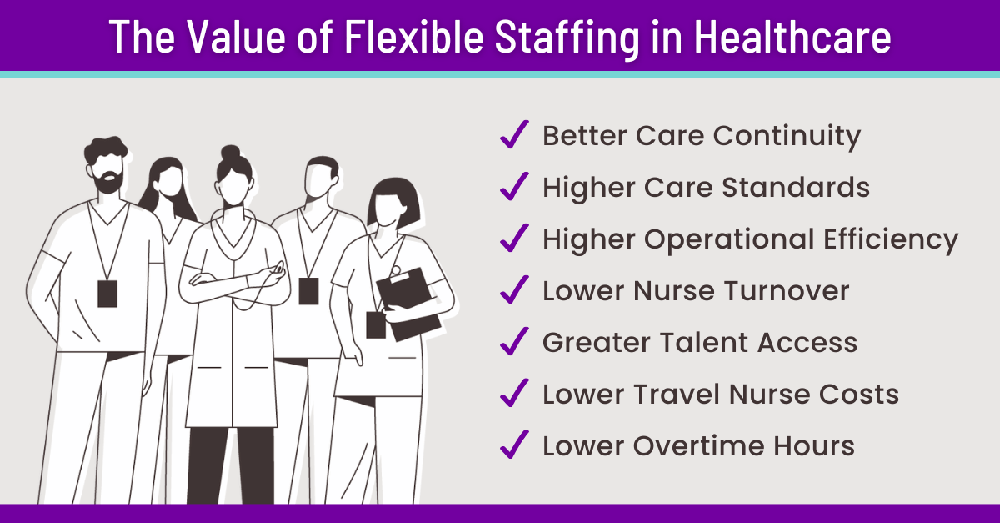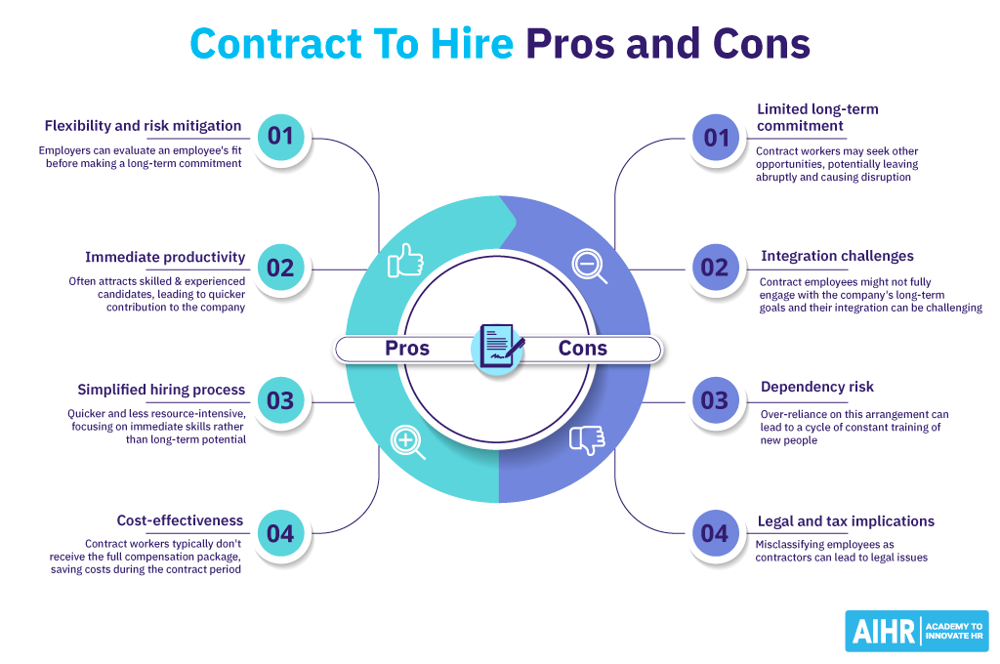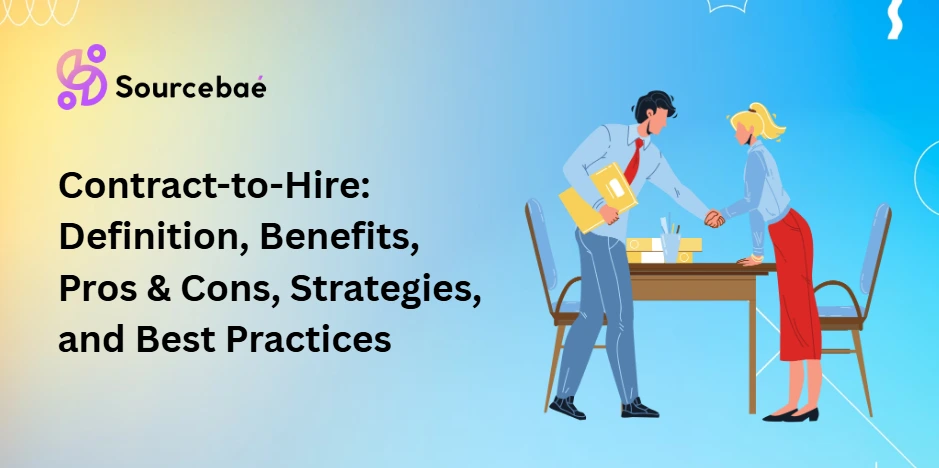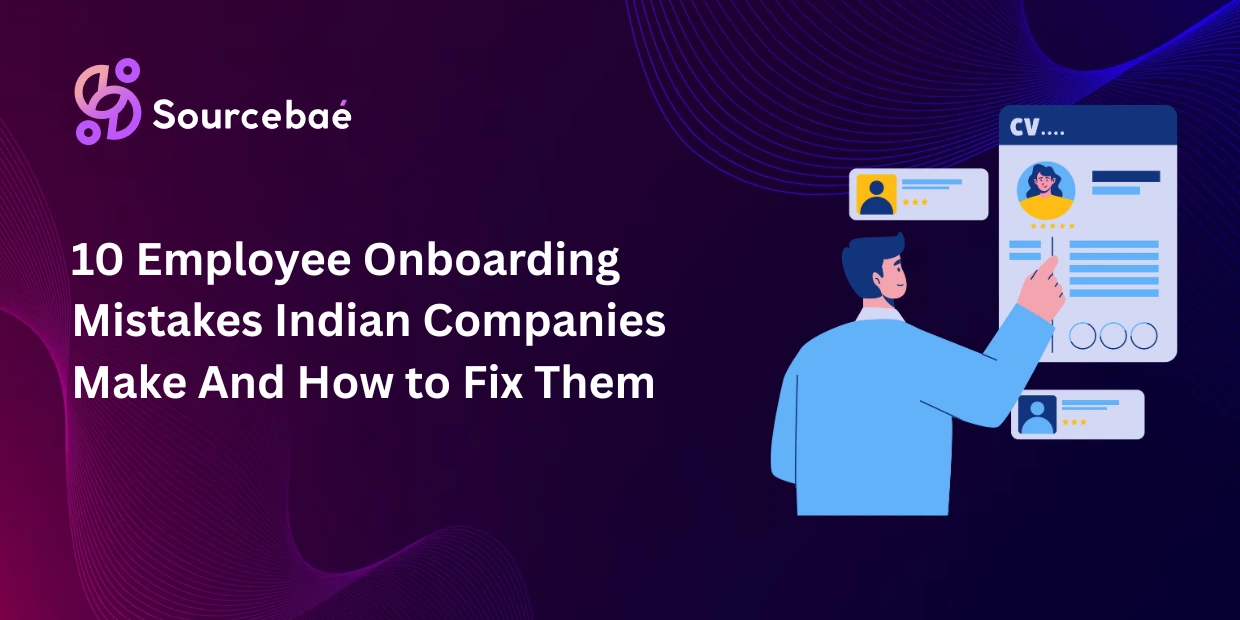Flexible staffing means using non-permanent workers (e.g. contract or temp staff) to meet changing needs. For example, in healthcare a recent report highlights benefits like better continuity of care, higher efficiency, and access to more talent when flexible staffing models are used. This agility lets companies scale up or down quickly. One common flexible model is contract-to-hire (C2H), also called temp-to-hire.
In C2H, a worker is first hired on a temporary contract and can later convert to a permanent employee if the trial is successful. Flexible staffing builds agility into workforce planning and helps address skill gaps on demand.

Contract-to-Hire: Definition & Overview
Contract-to-Hire (C2H) is a hybrid staffing arrangement. In C2H, an employee starts on a temporary contract (often for 3–12 months) with the possibility of becoming a full-time hire. Indeed defines it as “a short-term job that allows both parties to try out a role before committing to full-time employment,” typically with a set contract length.
An HR glossary similarly notes C2H “begins as a temporary or contract position but has the potential to become a permanent job”. Companies use C2H to evaluate a worker’s skills and fit before offering permanent employment. This trial period helps both the employer and the candidate confirm that the role is right for them.
Contract-to-hire positions mean an initial temporary job with option to convert to permanent. This approach is common in tech and other industries needing flexibility: a company can quickly fill a role (often via a staffing agency) and then convert only if the worker proves a good long-term fit.
What is a contract-to-hire position?
A contract-to-hire position is simply the job arrangement described above. The individual is brought on as a contractor (sometimes through a staffing agency) with a fixed contract duration, with the understanding that the job could become permanent.
AIHR explains that during the initial phase the employee usually works on contract for several months to a year. If after that trial both sides agree, the employee is hired as a full-time staffer. Essentially, it’s a built-in “trial period” for both the worker and employer.
How does contract-to-hire work?
The C2H process typically follows these steps:
- Contract agreement: The employer and worker sign a temporary employment contract (often 3–6 months, up to a year). This agreement defines the role and contract duration.
- Work phase: The individual performs the job duties just like any regular employee during the contract period.
- Evaluation: Throughout the contract, the employer evaluates the worker’s performance, skills, and cultural fit, while the worker decides if the company and role match their goals.
- Conversion decision: At the end of the contract, the employer chooses whether to offer a permanent position. If yes, the employee transitions to full-time status (with usual benefits). If not, the contract simply ends.
Often, staffing agencies assist with C2H roles: the agency recruits and places the candidate, puts them on its payroll, and handles initial taxes/benefits. In that case, the worker is typically a W-2 employee of the agency during the trial, until potentially moving onto the company’s payroll as a full-timer.
This arrangement gives employers flexibility (they pay only for the contract period unless they convert) and provides contractors with predictable pay even before full-time status.
Contract-to-Hire vs Direct Hire
It’s important to distinguish C2H from a standard hire. In contract-to-hire, the person starts on a temporary contract with the option of conversion. In direct (permanent) hire, the person is brought on as a full-time employee immediately, with no trial period. Key differences include:
- Employment type: C2H starts as a temporary placement, whereas direct-hire is immediately permanent.
- Payroll/Benefits: In C2H the contractor is often on a staffing agency’s payroll with limited benefits (if any). Direct hires go on the company’s payroll at once and receive full benefits from day one.
- Risk and commitment: C2H offers flexibility to assess fit before long-term commitment, while direct-hire commits the company immediately and typically involves more extensive HR processes.
- Turnover: C2H may experience higher turnover if contractors choose not to stay long-term, but it also can reduce the risk of a bad hire by allowing a trial.
In short, contract-to-hire combines elements of contract work and permanent placement. A pure contract job (not C2H) is usually short-term or project-based with no promise of permanence; by contrast, C2H is explicitly a temporary arrangement with a potential permanent outcome. (See the table below for a quick summary.)
| Hiring Model | Employment Term | Benefits & Payroll | Conversion Option |
|---|---|---|---|
| Contract (W-2/1099) | Short-term, project-based | Typically limited or through agency | ❌ (typically not) |
| Contract-to-Hire | Temporary (e.g. 3–12 months) | Agency or limited benefits during contract | ✅ (if trial succeeds) |
| Direct Hire | Permanent/full-time | Full benefits and payroll from day one | N/A (already perm.) |
Difference between Contract and Contract-to-Hire
While both involve “contract” work, there is a key difference. A plain contract (or contingent) worker is hired for a specific short-term need (e.g. a 3‑month project) with no promise of continued employment. They often work as independent contractors or through an agency and have no expectation of full-time status.
By contrast, a contract-to-hire is explicitly a temporary period designed as a trial. C2H roles are temporary with the potential to convert to a permanent role at the end of the contract. In other words, contract-to-hire is a “try-before-you-buy” version of a contract position.
Contract-to-Hire Pros and Cons

Both companies and workers see benefits in C2H, but there are trade-offs. The AIHR infographic below highlights the main pros (left) and cons (right) of contract-to-hire.
Key advantages of contract-to-hire include flexibility and productivity, while downsides involve limited commitment and potential legal issues.
Pros (Benefits):
- Flexibility & Risk Mitigation: Employers can evaluate a contractor’s fit before a long-term commitment. This “trial period” reduces the risk of a bad hire.
- Faster Hiring: Using staffing agencies and contract-to-hire can streamline recruiting; one study found companies cut hiring time by ~45% with agency-supported contracts.
- Access to Specialized Talent: C2H roles often attract skilled candidates who can contribute immediately, shortening onboarding time.
- Cost Savings: Contractors typically don’t receive the full permanent compensation package during the trial, saving employers up to ~30% in initial hiring costs.
- Lower Turnover Risk After Hire: According to SHRM, 74% of companies using contract-to-hire report reduced first-year turnover, since candidates have been pre-vetted through the trial.
- Candidate Advantage: For job-seekers, a C2H role is a chance to demonstrate skills, expand networks, and negotiate pay after proving value.
Cons (Considerations):
- No Guarantee of Hire: Even if you excel as a contractor, the company may choose not to convert you to permanent, leaving you job-searching again. Companies sometimes use C2H simply to fill a temporary gap.
- Benefit Gaps: Contractors often lack full employee benefits (health insurance, paid leave, etc.) during the contract. Some agencies offer limited benefits, but it’s typically not as comprehensive as a full-time package.
- Integration Challenges: Contract employees may feel less invested or have less access to company culture and perks, making team integration harder.
- Dependency on Agencies: Relying heavily on C2H can mean constantly training new people, which can be inefficient if workers leave before finishing projects.
- Legal & Tax Issues: Misclassifying workers or mismanaging contracts can lead to legal complications. It’s crucial to follow labor laws and clearly define W-2 vs 1099 status.
Companies using C2H should weigh these pros and cons. Staffing agencies often recommend C2H to save costs and improve hire quality, but also caution clients to set clear terms and timelines. Similarly, candidates should consider that while C2H can be a foot in the door, it comes with some uncertainty about long-term status.
Contract-to-Hire Benefits and Considerations
From a strategic standpoint, contract-to-hire offers several key benefits and requires careful planning:
- Agility and Cost-Efficiency: As noted, C2H gives businesses agility to scale staff up or down. Using agencies can reduce lead time and cost. For example, C2H positions are projected to grow in popularity as 15% of the U.S. workforce is already in temporary/contract roles (with growth expected), and agencies can cut hiring time nearly in half.
- Trial Period for Fit: Both employers and employees get an extended “test drive.” This can improve job satisfaction and performance because expectations are aligned in advance. Data show most companies see lower turnover and better cultural fit from this model.
- Budget Flexibility: Budgets can be controlled by limiting benefits during the trial. For example, contractors may receive basic health coverage via the agency but not company retirement plans until permanent hire.
- Legal/HR Considerations: HR must draft clear C2H agreements (see next section) and comply with employment laws. Companies should define evaluation criteria and conversion timelines upfront to avoid misunderstandings.
- Communication: Employers should communicate C2H terms (duration, evaluation process, etc.) clearly. Likewise, candidates should clarify goals and timelines (as in the FAQ below) to make the most of the trial period.
In sum, contract-to-hire offers flexible staffing that can reduce hiring risk and save costs. Tech companies and staffing agencies alike use C2H to quickly fill niche roles and vet candidates. However, success hinges on clear agreements and mutual understanding of the trial process.
What Should HR Include in a Contract-to-Hire Agreement?
A solid C2H agreement should spell out the key terms so both sides know what to expect. HR experts recommend including:
- Job Description & Duties: Clearly define the role, responsibilities, and expectations during the contract period.
- Contract Duration: Specify the length of the trial (e.g. 3 months, 6 months) before a permanent hiring decision is made.
- Compensation & Benefits: Detail the pay rate (salary or hourly) and any benefits the contractor will get (health insurance, paid time off, etc.) during the contract. Also state how compensation or benefits may change if they become permanent.
- Performance Criteria: Outline the goals, KPIs, or evaluation metrics the worker must meet for conversion to full-time. This aligns with questions (see FAQ) about goals and evaluation.
- Termination Terms: Specify how either side can end the contract early (notice period, termination rights).
- Confidentiality/NDA: Include any required clauses to protect company information, as you would in a regular employment contract.
By including these elements, HR ensures the C2H trial is structured and transparent. A clear contract helps avoid disputes and sets a roadmap for possibly becoming a permanent hire.
FAQ: Questions to Ask About a Contract-to-Hire Position
When interviewing for a contract-to-hire role, it’s smart to ask specific questions about the trial terms. Here are four key questions (and what they cover):
What goals will be set for this role?
Answer: This lets you clarify the employer’s expectations and key responsibilities. You should ask about daily tasks and performance targets (KPIs) so you know how your success will be measured. For example, find out what a typical day looks like and what specific deliverables or deadlines they expect during the contract.
How will I be evaluated as a temporary employee?
Answer: This uncovers the evaluation process. Ask if they plan to use supervisor reviews, peer feedback, project milestones, or software metrics to assess your work. Understanding this will tell you what environment you’re entering (fast-paced vs. methodical) and how the company decides whether to extend the contract or convert it to a full-time offer.
When do you plan to hire a permanent employee for this role?
Answer: This gets at the timeline. Inquire if they have a target date for converting the contract or a review period after which they make a full-time offer. Some employers have a set review (e.g. at 6 months), while others may decide later. If they don’t have one, you might suggest a timeline or agree to discuss it once you’ve settled in. Clarifying this ensures you know whether your contract will be short or if they might extend it.
What are the expectations of a permanent employee in this role?
Answer: This question is about the end goal. Find out what qualities or achievements a full-time hire should have. Asking what the hiring manager most values in a permanent employee helps you align your efforts during the contract. For example, they might emphasize leadership skills, technical proficiency, or cultural fit; you can then focus on demonstrating those traits.
By asking these questions, you get direct answers about how the trial works and what success looks like. This helps both you and the employer decide if the C2H arrangement will lead to a good long-term match.






